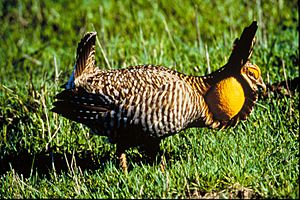Attwater's prairie-chicken facts for kids
Quick facts for kids Attwater's prairie-chicken |
|
|---|---|
 |
|
| Conservation status | |
| Scientific classification |
|
| Kingdom: | Animalia |
| Phylum: | Chordata |
| Class: | Aves |
| Order: | Galliformes |
| Family: | Phasianidae |
| Genus: | Tympanuchus |
| Species: | |
| Subspecies: |
T. c. attwateri
|
| Trinomial name | |
| Tympanuchus cupido attwateri Bendire, 1893
|
|
The Attwater's prairie-chicken (Tympanuchus cupido attwateri) is a very rare type of greater prairie-chicken. It used to live in the coastal areas of Texas and Louisiana in the United States. Today, it is one of the most endangered birds in North America.
Contents
Meet the Attwater's Prairie-Chicken
This special bird is about 17 to 18 inches (43-45.5 cm) tall and weighs around 1.5 to 2 pounds (0.7 to 0.9 kg). Its wings can spread up to 28 inches (70 cm) wide. These birds have cool patterns of dark brown and light buff-white stripes all over their bodies.
Boys and girls look a bit different. Male prairie-chickens have long feathers on their heads that stick up like ears. They also have bright orange or golden air sacs on their necks. They puff these sacs up during their mating dances to impress the females! These birds usually live for 2 to 5 years.
Where They Live
The Attwater's prairie-chicken naturally lives in the Western Gulf coastal grasslands. Long ago, their home stretched from Louisiana all the way to Texas, covering a huge area of 6 million acres (24,000 square kilometers).
Today, you can only find wild populations in two places. One is the Attwater Prairie Chicken National Wildlife Refuge near Eagle Lake, Texas. The other is on private land in Goliad County.
Mating and Chicks
From January to mid-May, especially in March, these birds gather in special spots called "booming grounds" or leks. These are open areas with short grass. Here, the males show off to the females.
The male prairie-chicken makes a deep "woo-woo" sound by inflating his neck sacs. He struts around, trying to attract a mate. Some traditional dances of Native American Plains tribes are even based on this amazing display!
In late spring, the female birds lay 10 to 14 eggs in nests hidden in tall grass on the ground. The eggs hatch after about 26 days. Sadly, only about 3 out of 10 eggs hatch, as predators often find the others. The baby chicks stay with their mother for about six weeks.
What They Eat and Who Eats Them
Attwater's prairie-chickens eat many different things. Their diet includes fresh grass shoots, flower petals, seeds, and insects like grasshoppers.
They also have natural enemies. Predators include hawks, owls, coyotes, raccoons, skunks, opossums, and snakes. Young chicks can also be in danger from floods.
Saving the Attwater's Prairie-Chicken
A long time ago, in 1900, there were about 1,000,000 Attwater's prairie-chickens. Their numbers have dropped a lot, mainly because they have lost their homes.
One big problem was when people started planting a tree called the Chinese tallow tree in the early 1900s. These trees spread very fast and took over the native grasslands where the prairie-chickens lived. Other non-native grasses also invaded their habitat. Plus, cities grew bigger, taking up more land.
Because of these changes, the grasslands where these birds once lived are now small, scattered patches. It's harder for the birds to move around in the thick plants.
In 1937, only about 8,700 Attwater's prairie-chickens were left. By March 1967, when they were put on the endangered species list, there were only about 1,070 birds left in the wild. By 2003, fewer than 50 birds remained.
In 1999, some drilling for oil was allowed near the birds' breeding grounds on land owned by The Nature Conservancy. This was seen as harmful to the birds. The number of prairie-chickens nesting there dropped from 36 in 1998 to 16 in 2003. Eventually, the birds disappeared from that spot.
Good news came in 2014, when about 260 birds were counted, with around 100 living in the wild. Many zoos and wildlife centers are helping with captive-breeding programs. Places like Fossil Rim Wildlife Center, Abilene Zoo, and Caldwell Zoo are raising these birds. The Houston Zoo even has a breeding group at the NASA Lyndon B. Johnson Space Center!
However, nature can be tough. In 2016, heavy spring floods wiped out many eggs, and the population dropped to 42 birds. Hurricane Harvey in 2017 was even worse, likely killing at least 32 birds. Only five females were found after the hurricane.
Despite these challenges, efforts continue. In February 2019, after the Houston Zoo released many birds, the wild population grew to about 200. But since then, the numbers have gone down again. A count later that year showed only 108 birds, and in February 2021, fewer than 100 were reported. People are still working hard to protect these amazing birds and their homes.
Images for kids
See also
 In Spanish: Tympanuchus cupido attwateri para niños
In Spanish: Tympanuchus cupido attwateri para niños
- Heath hen
- Henry Philemon Attwater



